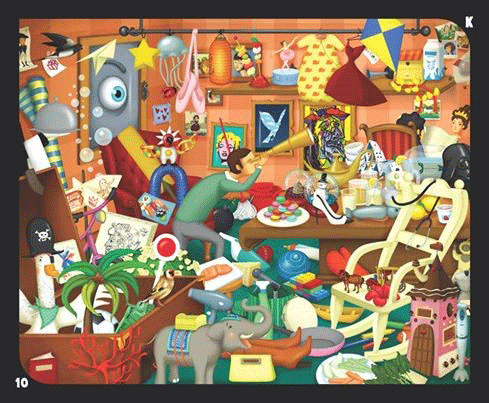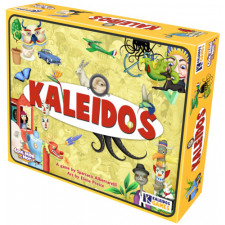Kaleidos Review
on Nov 30, 2016
Kaleidos is a celebrated party game from 1994 that has been made available again through a new 2016 publication from, of all publishers, Cool Mini or Not. There is neither a miniature nor a Kickstarter exclusive backer bonus to be found in the box, just a plain old hidden picture parlor game where minimal rules and super casual gameplay provide a loose framework for socialization. Mechanics and strategy aren’t the order of the day here, what matters is emergent interaction and of course lots of shared laughs and lighthearted disagreements. It’s the kind of game your grandma and your five year old cousin can play together and quite frankly, the only kind of player that is going to be put out by Kaleidos are the sour grapes “I hate party games†folks that will likely be off at another tale trying to convince everyone that a Stefan Feld design is “easy†to learn through 30 minutes of rules explanation.

“It’s like Hieronymus Bosch meets Pee-Wee’s Playhouseâ€- my cousin Ed.
The concept is that each player (or team) has a set of ten ridiculous paintings filled with random objects, visual non-sequiturs and well, just stuff. A card is drawn with a letter on it and everyone must write down the objects they see in the painting that start with that letter. Basic hidden picture stuff, but the twist to it is that sometimes what objects are or represent can be open to interpretation. For example, a poster might be just that, but it may also have something on it that fits for another letter. Or you might write it down as a flyer. Or maybe even ephemera. A kayak could also be a boat or a vessel. Where it gets really fun (and funny) is when players get REALLY liberal with their interpretations – and others dispute their logic!
Once a sand timer drains out, everyone reads out their lists and there are usually lots of “oh†and “why didn’t I see that†kinds of reactions. If you or your team is the only one to have listed an object, it’s three points. If more than one player or team has it written down, it’s just one point. So there is an incentive to be creative and not just go for obvious objects. And it is quite satisfying to have a killer round where you just rack up the points while everyone else struggles
A full game goes through the series of ten paintings, but you might find that folks are done after three, five, eight, whatever. Or they may want to play it all night. Even with only ten paintings and 26 letters there is plenty of replayability due to the massive amount of things you can find. Also, the natural range of difficulty (just wait for the groaning when the Z comes up) makes for some variety and you won’t really feel a sense of repetition even after a full night of play.

“Nothing in this $#@$%! picture starts with X!†– my cousin Ed.
But it isn’t quite as addictive or interesting as more recent party games like Codenames or Dixit and it lacks the more raucous laugh-out-loud hilarity of something like Time’s Up or Telestrations. So it may come across as less engaging for groups that have played those titles. But this is still, after 22 years, a fine social game with a supremely low barrier to entry and a universally appealing concept.

 Customer Support
Customer Support  Subscribe
Subscribe 




 Account
Account  Wishlist
Wishlist 

